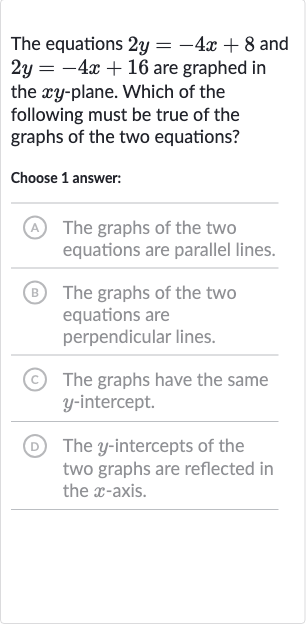AI tutor
Welcome to Bytelearn!
Let’s check out your problem:

The equations and are graphed in the -plane. Which of the following must be true of the graphs of the two equations?Choose answer:(A) The graphs of the two equations are parallel lines.(B) The graphs of the two equations are perpendicular lines.(C) The graphs have the same -intercept.(D) The -intercepts of the two graphs are reflected in the -axis.
Full solution
Q. The equations and are graphed in the -plane. Which of the following must be true of the graphs of the two equations?Choose answer:(A) The graphs of the two equations are parallel lines.(B) The graphs of the two equations are perpendicular lines.(C) The graphs have the same -intercept.(D) The -intercepts of the two graphs are reflected in the -axis.
- Equation Analysis: Let's analyze the first equation . To find the slope and y-intercept, we can put it in slope-intercept form, which is , where is the slope and is the y-intercept. Divide both sides by to isolate . Here, the slope () is and the y-intercept () is .
- Slope and Y-Intercept: Now let's analyze the second equation . Again, we put it in slope-intercept form by dividing both sides by . Here, the slope is and the y-intercept is .
- Comparison of Equations: Comparing the two equations, we see that they both have the same slope, , but different -intercepts, and respectively.Since they have the same slope, the lines are parallel to each other.
- Answer Choices: Now let's check the answer choices against our findings:(A) The graphs of the two equations are parallel lines. This is true based on our analysis.(B) The graphs of the two equations are perpendicular lines. This is false because perpendicular lines would have slopes that are negative reciprocals of each other.(C) The graphs have the same -intercept. This is false because the -intercepts are and .(D) The -intercepts of the two graphs are reflected in the -axis. This is false because a reflection across the -axis would not change the -coordinate of the -intercept, but would change the sign of the -coordinate.
More problems from Write a quadratic function from its x-intercepts and another point
QuestionGet tutor help
QuestionGet tutor help
QuestionGet tutor help
QuestionGet tutor help
QuestionGet tutor help
QuestionGet tutor help
QuestionGet tutor help
QuestionGet tutor help
